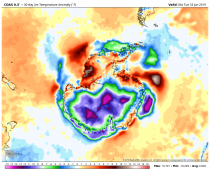By Allan M.R. MacRae, B.A.Sc., M.Eng.
Radical green extremists have cost society trillions of dollars and many millions of lives. Banning DDT and radical green opposition to golden rice blinded and killed tens of millions of children.
Green energy and CO2 abatement schemes, driven by false fears of catastrophic global warming, have severely damaged the environment and have squandered trillions of dollars of scarce global resources that should have been allocated to serve the real, immediate needs of humanity. Properly allocated, these wasted funds might have ended malaria and world hunger.
The number of shattered lives caused by radical-green activism rivals the death tolls of the great killers of the 20th Century - Stalin, Hitler and Mao - radical greens advocate similar extreme-left totalitarian policies and are indifferent to their resulting environmental damage and human suffering… and if unchecked, radical environmentalism will cost us our freedom.
The full article is supported by highly credible scientific and technical references.
In a newly released Kindle book that is set to peeve established climate science, an MIT doctorate climate researcher blasts alarmist claims of a warming planet and illustrates how temperature data are untrustworthy and far too scant to draw sound conclusions.
By Kirye and Pierre Gosselin
Dr. Kiminori Itoh just brought to our attention a recently released Kindle version Japanese climate skeptical book authored by Dr. Mototaka Nakamura. an scientist who received doctorate from MIT.
The book’s title translated in English: “A climate scientist’s profession - Global warming theory is unproven, only a hypothesis”.

Climate scientist Dr. Mototaka Nakamura’s recent book blasts global warming data as “untrustworthy”, “falsified”. Image: http://iprc.soest.hawaii.edu/people/nakamura.php
In his book, Dr. Nakamura explains why the data foundation underpinning global warming science is “untrustworthy” and cannot be relied on.
“Not backed by demonstrable data”
He writes that although many people, including a lot of climate researchers, believe it is a confirmed fact that global surface mean temperatures have been rising since Industrial Revolution, it is however “not backed by demonstrable data”. He points out:
Global mean temperatures before 1980 are based on untrustworthy data. Before full planet surface observation by satellite began in 1980, only a small part of the Earth had been observed for temperatures with only a certain amount of accuracy and frequency. Across the globe, only North America and Western Europe have trustworthy temperature data dating back to the 19th century.”
Prestigious career
Dr. Nakamura received a Doctorate of Science from the Massachusetts Institute of Technology (MIT), and for nearly 25 years specialized in abnormal weather and climate change at prestigious institutions that included MIT, Georgia Institute of Technology, NASA, Jet Propulsion Laboratory, California Institute of Technology, JAMSTEC and Duke University.
Failed climate models
Nakamura’s book demolishes “the lie of critical global warming due to increasing carbon dioxide”, exposes the great uncertainty of “global warming in the past 100 years” and points out the glaring failure of climate models.
Only 5% of Earth’s surface adequately measured over past 100 yrs
According to Dr. Nakamura, the temperature data are woefully lacking and do not allow in any way the drawing of any useful conclusions.
Presently the book is available in Japanese only. What follows are translated/paraphrased excerpts.
For example, Dr. Nakamura illustrates how scant the global temperature data really are, and writes that over the last 100 years “only 5 percent of the Earth’s area is able show the mean surface temperature with any certain degree of confidence.”
Ocean data extremely scant…
Then there’s the desolate amount of data from the massive oceans. Later Dr. Nakamura describes how the precision of the observed mean temperature from the ocean surface, which accounts for roughly 75% of the Earth’s surface, are questionable to an extreme.
He writes, “The pre-1980 temperature data from the sea and water are very scant” and that the methodology used for recording them totally lacks adequacy.
To top it off: “The climate datasets used for the sea surface water temperature data have added various adjustments to the raw data.”
1 station per 10,000 sq km almost meaningless
Dr. Nakamura also describes how the number of surface stations used globally cannot provide any real accurate temperature picture. He writes: “Experts cannot just decide that 10,000 sq km per station is representative of temperature.”
Later he explains: “If you accept the Earth surface mean temperature’s warming since the Industrial Revolution as the truth, it means you agree with the idea that the Earth surface mean temperature rise can be determined by a biased tiny region on the globe. It is nonsense. Looking at the regions with long term temperature data, you can see that some regions warmed, and some other regions cooled.
Nakamura’s harsh judgement: “No scientific value”
Finally, Nakamura blasts the ongoing data adjustments: “Furthermore, more recently, experts have added new adjustments which have the helpful effect of making the Earth seem to continue warming”. The talented Japanese scientist deems this “data falsification”.
He concludes:
Therefore, the global surface mean temperature change data no longer have any scientific value and are nothing except a propaganda tool to the public.”
--------
BTW: Mark Albright reports the Antarctic in a deep freeze - Over the past 30 days the interior of Antarctica has been running 13 F below normal.

by Allan M.R. MacRae, B.A.Sc., M.Eng, June 2019
Allan MacRae is an Alberta Professional Engineer with engineering degrees from Queen’s and the University of Alberta. He is an energy expert with a track record of significant accomplishment on six continents.
See his highly recommended thorough analysis with charts and data here. Here is the accompanying EXCEL file.
ABSTRACT
* Global warming alarmism, which falsely assumes that increasing atmospheric CO2 causes catastrophic global warming, is disproved - essentially, it assumes that the future is causing the past. In reality, atmospheric CO2 changes lag global temperature changes at all measured time scales.
* Nino34 Area Sea Surface Temperature changes, then tropical humidity changes, then atmospheric temperature changes, then CO2 changes.
* The velocity dCO2/dt changes ~contemporaneously with global temperature changes and CO2 changes occur ~9 months later (MacRae 2008).
* The process that causes the ~9-month average lag of CO2 changes after temperature changes is hypothesized and supported by observations.
* The ~9-month lag, +/- several months, averages 1/4 of the full-period duration of the variable global temperature cycle, which averages ~3 years.
* Based on the above observations, global temperatures drive atmospheric CO2 concentrations much more than CO2 drives temperature.
* Climate sensitivity to increasing atmospheric CO2 must be very low, less than ~1C/(2*CO2) and probably much less.
* There will be no catastrophic warming and no significant increase in chaotic weather due to increasing CO2 concentrations.
* Increasing atmospheric CO2 clearly causes significantly improved crop yields, and may cause minor, beneficial global warming.
* Atmospheric CO2 is not alarmingly high, it is too low for optimal plant growth and alarmingly low for the survival of carbon-based terrestrial life.
* Other factors such as fossil fuel combustion, deforestation, etc may also increase atmospheric CO2. The increase of CO2 is clearly beneficial.
* “Green energy"schemes are not green and produce little useful (dispatchable) energy, primarily because of the fatal flaw of intermittency.
* There is no widely-available, cost-effective means of solving the flaw of intermittency in grid-connected wind and solar power generation.
* Electric grids have been destabilized, electricity costs have soared and Excess Winter Deaths have increased due to green energy schemes.
HYPOTHESIS AND CONCLUSIONS
* Earlier conclusions by the author and others are reviewed that disprove global warming alarmism and the justification for CO2 abatement schemes.
* Increasing atmospheric CO2 does NOT cause dangerous global warming. Human made global warming / climate change is a false crisis.
* Atmospheric CO2 changes lag global temperature changes at all measured time scales.
* The process that causes the ~9-month average lag of CO2 changes after temperature changes is hypothesized and supported by observations.
* This ~9-month lag, +/- several months, averages 1/4 of the full-period duration of the variable global temperature cycle, which averages ~3 years.
See his highly recommended analysis with charts and data here.


